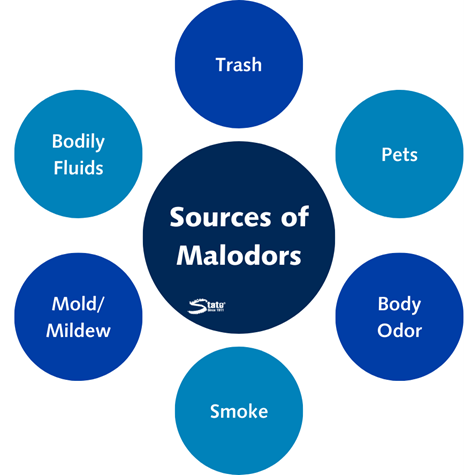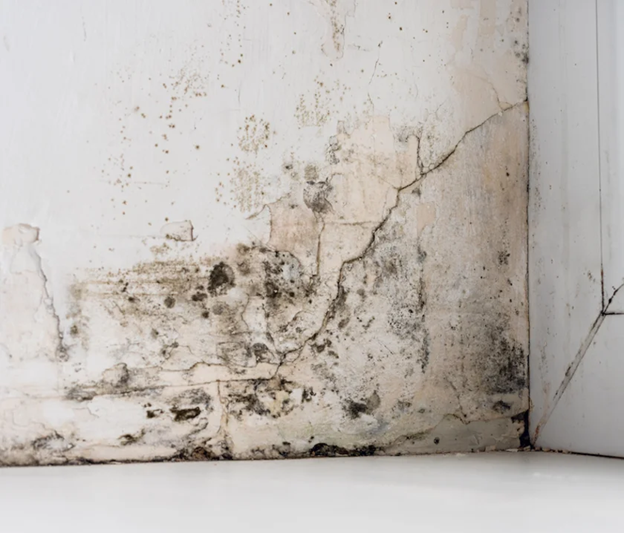Why Does My Facility Smell?
Why Does My Facility Smell?
Imagine this: you oversee the sanitation of an assisted living facility. Your staff does everything they’re tasked to keep the facility clean, but there’s no denying it: the building smells. Even through the lobby, there’s a lingering scent of body odor. You notice it and guests notice it—if you’re keeping things as clean as you can, why is this happening? And how can you get rid of it before it deters visitors?
In business since 1911, State Chemical is a chemical solutions company that has seen a lot of different odor problems. We know it can be challenging to get to the bottom of an issue—even more so when you’re anxious to find a solution.
To help you understand your odor problems, we’ll explain where your malodors may be coming from, how they impact your business, and how to get rid of them. After reading, you’ll know what your odors could be linked to and what your first step toward odor elimination is.
Where Do Odors Come From?
When it comes down to it, malodors can come from virtually anywhere, usually being associated with bacteria. But most of the time, they fall under the umbrella of several types of odors:
Trash Odors
It’ll usually be pretty obvious when your facility is experiencing trash odors. If you’ve ever held your breath while opening a dumpster, you know this. While the severity varies depending on the specific area (e.g., trash rooms will be more pungent than a dumpster due to less ventilation), when you’re dealing with rotting organics and bacteria, malodors spread quickly.
Typically, trash odors will be among the most unpleasant for a facility to deal with.
Body Odors
An issue you don’t always consider is body odor. Unfortunately, when many individuals go through a space over time, the space tends to hang onto body odors, such as those caused by sweat. The room itself can hang onto these odors, or they can be absorbed by furniture and fabrics.
For example, let’s say you run a fitness center. With people working out in your facility every day, the area smells thoroughly like sweat. No matter the location, in a situation like this, body odor is going to linger in the open.
Meanwhile, if you ran the assisted living facility from the beginning, the smell might be in the air, but it’s also probably clinging to fabrics. Just think about people sitting on the same couches every day—after a bit, their sweat will seep into the couch, giving it that distinctive odor.
Odors from Bodily Fluids
It may be gross, but bodily fluids can also cause odors in your facility. This can include urine, blood, vomit, and more.
Let’s imagine for a minute that you work in a hospital’s trauma center. With severe wounds and constant surgeries, your facility sees a lot of blood—and when you’re in an enclosed room with a lot of blood, it smells. And if this occurs at a high frequency, the metallic odor will start to linger in the space. Now, you’re in a situation where visitors are panicking because the facility smells like blood.
This is an extreme example, but the same goes for other bodily fluids in your facility. And when people walk in and smell other people’s bodily fluids, chances are that they’re not going to hang around.
Mold & Mildew Odors
Additionally, mold and mildew can give your facility a musty scent, which doesn’t help forge positive associations with visitors. However, your issue is more than the odor.
Mold and mildew are unhygienic and can cause allergic reactions and other health issues. For the safety of your staff and other facility users, it’s best to treat for mold and mildew rather than for odor elimination.
Smoke Odors
Where there is smoking, there are smoke odors, and these really linger. This is true in the sense that smoke odors will linger in a room on their own, but the odors are especially difficult when they’re absorbed by fabric and furniture.
Suppose you’re a hotel manager. If a room reeks of cigarettes no matter how many times you spray it down with air freshener, it’s likely that this odor has been absorbed in the drapes, upholstery, and bedding. This becomes a different kind of problem for you as you scramble to prepare the room for future guests.
Pet Odors
Pet odors are the problem that plagues all animal lovers. As much as you may welcome furry friends into your facility, the fact remains that they can create something of a mess. Urine, animal dander, fecal matter, and more can create odor problems for your facility, and no one wants themselves or their pets in an environment that smells unclean.
How Do Smells Impact Your Business?
Knowing how all of these odors might look in your facility, the question remains: how will this affect your business?
Odors are obviously not the way to leave a good impression on customers. Scent is a strong trigger of memory, so when your facility has a bad smell, it develops a negative connotation in a customer’s mind.
Think about a place you’ve gone to where the smell struck you as unpleasant. It might be a thrift store that smelled musty, a restaurant bathroom that smelled like rotten eggs, or a friend’s house that smelled of cat urine. Whatever it may be, an unpleasant image comes to mind, and you probably don’t want your facility users to feel that way about your location.
But the impact of smell doesn’t need to be negative. On the flip side, a good fragrance can foster positive associations in the minds of your customers.
Think about a place you’ve gone that smelled good. Maybe it was a bakery that smelled like fresh pastries, a local store with lavender sachets on each shelf, or a relative’s house with a caramel spice candle. It’s easier to remember the locations that strike you as pleasant-smelling, and when you treat your odor problems, customers will view your business this way too.
How to Eliminate Odors in Your Facility
The first step toward odor solutions is determining what kind of solution will work for your specific problem.
First, consider where the odor is coming from. If it’s a continuous problem for the room as a whole, look into an odor-eliminating air freshener or a fragrance system. These solutions will treat odors in the air while also adding a pleasant fragrance to your space if desired.
Meanwhile, if the odor comes from a specific area, such as a piece of furniture or a dumpster, invest in a product for odor spot treatment. This can mean a fabric refresher, a handheld odor eliminator, or another ready-to-use product targeted toward a specific area.
Once you know what kind of solution you need, you can continue to research products based on your personal needs (e.g., allergy-friendly options) and find the best product for your facility.
Learn About Fragrance Solutions
Odor problems are everywhere, and they can be challenging to solve when there are many potential solutions. Now that you know where your odor problems might stem from and how to solve them, learn more about commercial fragrance concerns and solutions here.













